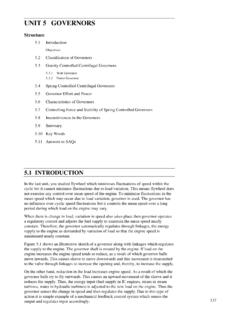Transcription of PWM Spindle Control using Mach3 - dave.ogormanfamily.com
1 Created By Chris Humphris Revision A Page 1 25/07/2010 PWM Spindle Control using Mach3 Introduction This document outlines my method of controlling Spindle speed on various machines. I wanted to pass on to others the experience I gained when I designed and manufactured my cnc lathe. Hopefully this dissertation will make it easier for others. Consideration of Pulse Width Modulation (PWM) Control only is covered. It does not cover Step and Direction or simple Relay Control of Spindle motors. It also assumes that a Variable Frequency Drive (VFD) is going to be used to Control a synchronous 3 phase AC Motor for the Spindle motor. The settings for the VFD refer to a Danfoss FC51 VLT Micro Drive. I have no experience with other brands or models although I suspect that the operation of most VFDs is roughly the same. The Spindle on my cnc lathe is controlled using the following components: An old Dell Inspiron 8600 Laptop with a Centrino Processor and 1GB RAM (with no parallel port) and always the latest Version of Mach3 USB Control via a Warp9 Smoothstepper with Plugin Version controlled by Mach3 Cnc4pc C23 Breakout Board directly connected to the Smoothstepper Danfoss FC51 VLT Micro Drive VFD Rototech 3 Motor A simple homemade PWM to Analogue DC Voltage Converter (Details covered later) A Spindle Index Pulse generator based on an Optek Technology OPB982T51Z Optocoupler The block diagram I came up with using Open Office Draw shown below was essential during initial planning and design of the cnc lathe electronics.
2 Created By Chris Humphris Revision A Page 2 25/07/2010 Planning for your Spindle Control When designing and building my cnc lathe, I quickly realized that you need to fully understand what you are trying to achieve when attempting to fully Control your Spindle speed with Mach3 . A plan is essential to consider all that is needed to Control you Spindle speed, direction and synchronization. using such a plan minimizes mistakes and helps to makes things work as intended. It also provides a baseline to go back to if things start to go off the rails. I would advise the following points be considered before starting: 1. Pulley Ratio (an accurate ratio is required for Mach3 to be able to calculate the correct PWM to Control the Spindle motor closely). 2. The maximum and minimum speeds (RPM) that the Spindle will experience in normal operation. 3. Spindle Rotation Feedback mechanism for synchronous operations such as threading.
3 4. Selection of a Base Frequency for PWM. 5. A method of controlling forward (M3) and reverse (M4) Spindle direction. 6. Motor Output Signal Setup for Mach3 Pins and Ports. 7. Spindle Input Signals required for Mach3 Ports and Pins. 8. A method of converting PWM signals from Mach3 to a DC Voltage to Control VFD frequency and hence, Spindle rpm. 9. The correct Spindle Setup under Mach3 Ports and Pins. 10. Whether the logic needs to be High or Low for various Ports and Pins settings to be used. 11. A method of calibrating the Spindle rpm to Mach3 commanded rpm. Created By Chris Humphris Revision A Page 3 25/07/2010 Software Bugs I have to contend with Mach3 has a bug in the initial commanded Spindle speed under PWM Control . It manifests itself as resulting in a higher initial speed than that requested. For example, on my lathe, if you request S500 the Spindle will go to 643rpm.
4 If you then perform either of the following actions, the speed will come back to the requested 500rpm: 1. Press Spindle Speed Override Reset Button, or 2. Issue another S500 command from Mach3 via DRO or MDI Subsequent requested Spindle speeds are then true until you stop the Spindle and start again. I don t know if this bug exists under Step and Direction Controlled spindles because all my machines use PWM and they all exhibit this problem. It has nothing to do with Smoothstepper because one machine is not controlled with a Smoothstepper and it behaves exactly the same. My workaround for this bug is to ensure that the following G Code example (or equivalent) to start the Spindle is inserted into all of my cnc programs: M3 S500 (Request Start Spindle CW at 500rpm but it goes to 643rpm) G4 P1 (Wait for 1 second) S500 (The Spindle then comes back to 500rpm) SmoothStepper has a bug in that the G4 Dwell command is expressed in Seconds regardless of what you set it to in Mach3 / General Config.
5 I use Plugin Version because the Spindle rpm DRO function works for me. I cannot get the Spindle rpm DRO in later Plugin Versions to work. Being able to read accurate rpm values is important to me. Pulley Ratio Mach3 needs to know the difference in rpm between the driving motor and the Spindle in terms of an accurate ratio. This ratio (which needs to be expressed as Spindle rpm to Motor rpm) must be calculated or measured and entered into Mach3 in the dialog box shown in Figure 4. Pulley setup is covered in detail in the Mach3 Mill Manual in Section If the Spindle is driven directly by the motor, the ratio is 1:1. Mach3 allows for up to 4 pulley ratios to be setup individually. Because I have only one pulley, I setup for Pulley 1 (the default) only. To calculate the ratio, I used the method of measuring accurately the rpm of the motor shaft and Spindle shaft and dividing the Spindle rpm by the motor rpm.
6 (Example below) I use an inexpensive laser digital optical tachometer shown in Figure 1 to do the measurements. I attached small pieces of adhesive reflective tape supplied with the tachometer attached to the motor and Spindle shafts. The reflective tape gives a good return for the laser beam resulting in stable rpm readings. Pulley Ratio Calculation 1. Turn on the Spindle using the manual mode on the VFD and adjust the speed Control potentiometer until the Spindle rpm as read on the tachometer is exactly 500rpm. 2. Measure and note the rpm of the motor shaft whilst the Spindle is at 500rpm. (in my case, this was 1725rpm) 3. Divide 500 by 1725 which = (Pulley Ratio) 4. Enter into the ratio dialogue box as shown in Figure 4. This is all Mach3 needs for the pulley ratio. Created By Chris Humphris Revision A Page 4 25/07/2010 Figure 1 Typical Laser Tacho and Potentiometer Trim Tool Figure 2 Reflective tape adhered to the motor pulley and Spindle shaft Figure 3 Close up of reflective tape on motor pulley.
7 Created By Chris Humphris Revision A Page 5 25/07/2010 Minimum and Maximum Spindle RPM 1. In Mach3 , Use Config / Spindle Pulleys to open the dialogue box shown in Figure 4. 2. Choose Pulley Number 1. 3. Set your desired minimum and maximum Spindle rpm. I used 200 and 1500rpm as shown in Figure 4. My minimum designed speed was 250rpm and maximum designed speed was 1150rpm. Choosing 200 and 1500rpm as shown ensures that Mach3 does not detect and present an error unless the actual speeds exceed the set limits during normal operation. Figure 4 Spindle Rotation Feedback In order to be able to perform synchronized operations such as threading, it is imperative that Mach3 is fed with rotational information on a continuous basis. Mach3 requires information in the form of one clean pulse per revolution. I used a disc with a single 8mm wide slot mounted to the Spindle shaft as shown in Figures 8 and 9 and an Infrared Optocoupler.
8 Set up the configuration under Ports & Pins / Spindle Setup / Special Functions as shown in Figure 5. Do not use Closed Loop Spindle Control . Selecting Use Spindle Feedback in Sync Modes tells Mach3 to expect feedback pulses from the Spindle . Selecting this effectively puts Mach3 into a closed loop mode. Selecting Spindle Speed Averaging allows Mach3 to average out minor speed fluctuations thus electronically smoothing out synchronized operations. Under Motor Control , checking Use Spindle Motor Output tells Mach3 to use a user defined Output Pin (See Figure 11 for example where Spindle is checked and the Output Pin is chosen to be Pin 14 on Port2) Because my VFD required a forward (Start) and reverse 24 VDC signal from the VFD itself, I chose to use 2 existing relays on the Breakout Board (BOB) to perform this function. Therefore, I chose not to check Disable Spindle Relays under Relay Control .
9 (See Figure 5) I then selected Clockwise (M3) to Output 1 and CCW (M4) to Output 2 as shown in Figure 5. Choosing Relay Control meant that Relay Control Outputs 1 & 2 also needed to be enabled and pins assigned as shown in Figure 10. Created By Chris Humphris Revision A Page 6 25/07/2010 Figure 5 Mach3 Ports & Pins Spindle Setup Spindle Index Pulse Generator Figure 6 shows the schematic diagram of an eminently suitable index pulse generator. The clever thing about the OPB982T51Z is that everything needed to generate a clean, rail to rail index pulse is contained in the Optocoupler itself. All that you need to add is an external limiting resistor R1 for the internal Infrared diode. Figure 7 shows several external limiting resistors mounted directly to 5 VDC outputs on the BOB. The optocoupler is available from Farnell, Newark or Digikey. Cost is very reasonable.
10 Figure 6 IC2 Schmitt Trigger for Accurate Pulse Generation Totem Pole O/P gives Rail to Rail Pulse Swing Created By Chris Humphris Revision A Page 7 25/07/2010 Figure 7 Details of how to mount the IR Diode Limit Resistor to 5 VDC on C23 BOB Figure 8 Index Pulse Generator Fitted to Spindle Shaft with a Single 8mm Slot Disc Figure 9 R1 270R IR Diode Limit Resistor Created By Chris Humphris Revision A Page 8 25/07/2010 Mach3 Output Settings Controlling Forward and Reverse Spindle Rotation Figure 10 Output 1 and 2 were selected as Forward & Reverse Relay Control . In the example above, Output 1 (CW Rotation M3) is configured to Control Relay 1 on the BOB via Pin 1 of Port 1. Output 2 (CCW rotation M4) is configured to Control Relay 2 on the BOB via Pin 16 of Port 1. Because each relay on the BOB has VCC on one side of the coil, Active Low needs to be selected to activate each relay when either M3 or M4 is commanded by Mach3 .








